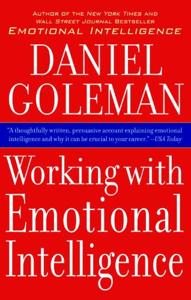
Want to learn the ideas in Working With Emotional Intelligence better than ever? Read the world’s #1 book summary of Working With Emotional Intelligence by Daniel Goleman here.
Read a brief 1-Page Summary or watch video summaries curated by our expert team. Note: this book guide is not affiliated with or endorsed by the publisher or author, and we always encourage you to purchase and read the full book.
Video Summaries of Working With Emotional Intelligence
We’ve scoured the Internet for the very best videos on Working With Emotional Intelligence, from high-quality videos summaries to interviews or commentary by Daniel Goleman.
1-Page Summary of Working With Emotional Intelligence
Overall Summary
In his book, Working with Emotional Intelligence, Daniel Goleman presents evidence that emotional intelligence is the most important factor in achieving success. He explains how it can be achieved through training and gives examples of how to improve your emotional intelligence at work.
The author of the book “Emotional Intelligence” states that there is a new type of intelligence, emotional intelligence. This type of intelligence has been called soft skills before and it’s critical to accomplishing one’s goals in life. The research conducted by Goleman shows that leaders who are good at emotional competence are much more successful than those who aren’t. Moreover, this importance rises as one ascends the corporate ladder—the higher you go up, the more important emotional competence becomes.
Emotional intelligence supports the acquisition of emotional competence. According to Goleman, there are twenty-five emotional competencies that can be learned. He groups them into five categories, three of which are “personal competencies,” while two are “social competencies.” The first personal category is self-awareness; the second is self-regulation (controlling impulses); and the final one is motivation. The first social category is empathy (understanding others’ feelings), while the other social category consists of social skills (the ability to elicit cooperative responses from others).
The second section of the book deals with twelve personal competencies. The first is self-mastery, which comes from our gut feelings. Goleman argues that these gut feelings guide us and help us make decisions in life by sending information to our brain through nerve pathways.
The human brain has a working memory that helps us to think and plan for the future. When we feel stressed, our emotions tend to take over the brain’s working memory, resulting in anxiety or anger. However, self-regulation is important because it allows us to manage our impulses and control what happens around us through cooperation between the emotional and executive parts of the brain. It is critical for five personal competencies: self-control, trustworthiness, conscientiousness, adaptability and innovation.
According to Goleman, the most powerful motivators are internal and not external. He says that people who enjoy their work or have a sense of flow while working will do better than those who don’t. In order for this to happen, however, you need to find something that excites you and challenges your skillset. If you can accomplish both these things then you’ll be able to achieve more in terms of success at work and overall happiness with your job.
The third section of the book, “People Skills,” talks about how to be a good leader. People skills are important in any business situation. The first social competency is empathy, or understanding others and their reactions. After that come four other social competencies: service orientation, leveraging diversity, political awareness, and influence. These five help with leadership and change catalyst.
The final four social competencies that typify “star performers” rely on the ability to coordinate with others. Social coordination is when people work together and maximize their potential as a team, which can lead to better performance than if each person worked individually.
The fourth section of the book presents a “new model for learning.” The author says that millions of dollars are wasted on training programs because they lack methods to change behavior. He co-founded a research organization, which developed guidelines for teaching emotional competence in organizations. These guidelines include fifteen best practices grounded in scientific research on behavior change. They’re most effective when used in combination with one another and can be illustrated by anecdotes from the author’s experience working with companies around the world.





